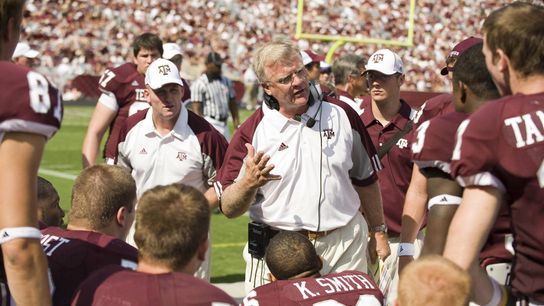Mike Sherman's tenure at Texas A&M followed a predictable path of successful coaches through his first three seasons in College Station. There was the 4-8 debut campaign of 2008 while emerging from the smoking wreckage left behind by the previous regime. The 2009 season was similarly frustrating, with blowout losses paired with close setbacks in winnable games, but signs of life appeared in a near upset of No. 3 Texas and a bowl appearance versus Georgia. Then there was the breakthrough season of 2010. Texas A&M closed the regular season with six straight victories, beating Texas, Oklahoma, Nebraska and Texas Tech in the same season for the first time in school history.
The 2011 seasons, Sherman's fourth, was supposed to be the season Texas A&M arrived as a true contender for both the Big 12 and the national championship. The Aggies started the season ranked eighth by the Associated Press and ninth in the Coaches Poll, blew out SMU and Idaho to open the season, and built a 20-3 halftime lead against No. 7 Oklahoma State in the biggest game Kyle Field had hosted in 36 years. And then the bottom fell out, as the Cowboys stormed back for a 30-29 win that would set the course for what would become Sherman's final campaign as the Aggies' head coach. The very next week, Texas A&M built a 35-17 halftime lead over No. 18 Arkansas, and lost 42-38. A month later, Texas A&M constructed a 28-17 halftime edge against Missouri, and lost 38-31 in overtime. The following Saturday, A&M traveled to Norman and played No. 7 Oklahoma to a 10-9 halftime lead, but got outscored 28-0 in the third quarter and lost 41-25. And then again the next week, the Aggies built a 21-14 lead over No. 17 Kansas State through three quarters, and ultimately fell 53-50 in four overtimes.
The final straw came on Thanksgiving, when A&M, now out of the top 25, again built a halftime lead - 16-7 over archrival Texas - and again witnessed it crumble away into a 27-25 defeat. It was the Aggies' fourth loss in five games, and sixth time in 10 games that it had lost a game in which it held a lead in the second half.
Sherman was fired eight days after the Texas game. New head coach Kevin Sumlin watched Texas A&M's Meineke Car Care Bowl victory over Northwestern - a game A&M led 30-7 through three quarters and hung on for a 33-22 victory - from a Reliant Stadium suite.
R. Bowen Loftin, the man who made the decision to replace Sherman and ever the self-promoter, has written a book about his transformative tenure as Texas A&M's president. The book, summarized by Brent Zwerneman of the Houston Chronicle, focuses primarily on Loftin's charge to take Texas A&M out of the Big 12 and into the SEC, but he wrote about what finally drove him to the decision to make that coaching change.
Outside of Sherman's resistance to his employer's impending conference relocation, Loftin chose to dismiss Sherman after this post-season conversation: "Sherman began raising some points that sounded more like excuses. He mentioned that recruiting was going really well, but he then said something that really struck me as odd: He basically attributed the 6-6 season to a lack of senior leadership. That stuck in my craw. … After four years on the job, he had not had enough time to develop senior leaders? Really? How long would it take - five, six, 10 years?
"Along with all the other strikes against him," Loftin writes, "that comment put me over the top."
The point of this piece is not to disparage Sherman. He is an accomplished, well-respected coach. His letter to Texas high school coaches written after his firing was a display of utmost class, and it remains one of the most-read pieces of our site.
It's that for all of us, university president, head coach, graduate assistant, undergraduate trainer, have a superior(s) we report to, and not one of them are interested in our excuses.
